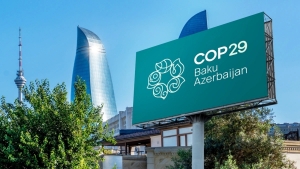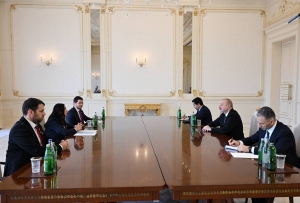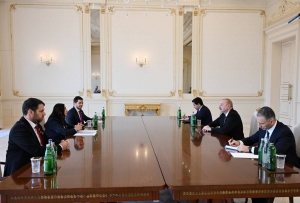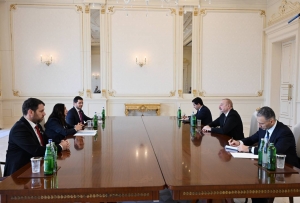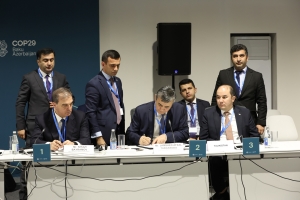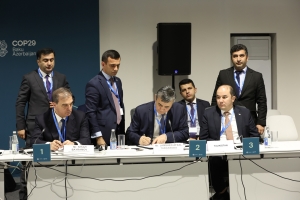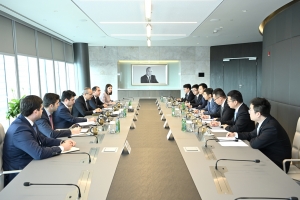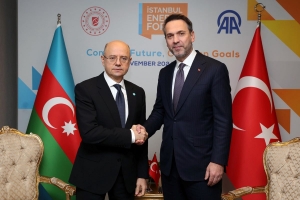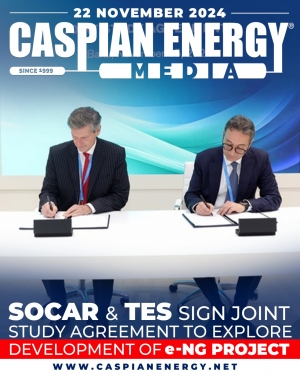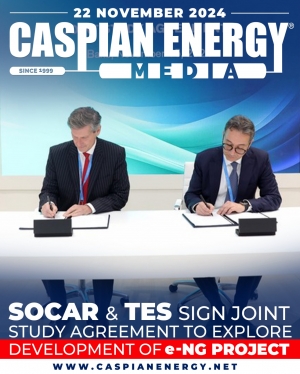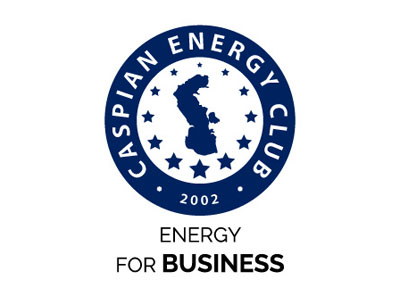Super User
В Баку завершила работу 29-я конференция ООН по изменению климата
Приоритеты и основные соглашения 29-й Конференции ООН по изменению климата (КС-29)
Свыше 72 000 участников из 196 стран собрались 11-22 ноября на 29-й Конференции ООН по изменению климата (КС-29). Среди них 80 президентов, вице-президентов и премьер-министров. Страны представили свои доклады и позиции по вопросу климатических изменений и дальнейшей стратегии по снижению выбросов углерода, метанола и других примесей в атмосферу.
Генеральный секретарь ООН Антониу Гутерриш выступил с речью на церемонии открытия Саммита мировых лидеров 12 ноября.
Он отметил, что мы находимся на последнем этапе обратного отсчета, чтобы ограничить рост глобальной температуры 1,5 градусами по Цельсию. И время не на нашей стороне. По словам Гутерриша, Oxfam обнаружил, что самые богатые миллиардеры выбрасывают больше углерода за полтора часа, чем среднестатистический человек за всю жизнь. На COP28 вы все согласились отказаться от ископаемого топлива; Ускорить системы чистой нулевой энергии, установив вехи для достижения этого; Ускорить адаптацию к изменению климата и согласовать следующий раунд общеэкономических национальных климатических планов — или NDC — с пределом в 1,5 градуса. Человечество за вами: опрос Оксфордского университета и Программы развития ООН показывает, что восемьдесят процентов людей во всем мире хотят больше действий по борьбе с изменением климата. Ученые, активисты и молодые люди требуют перемен — их нужно услышать, а не заставить замолчать. И экономический императив становится все яснее и убедительнее — с каждым запуском возобновляемых источников энергии, каждой инновацией и каждым падением цен.
В прошлом году — впервые — объем в $2 трлн. инвестиций в сети и возобновляемые источники энергии превысил объем расходов на ископаемое топливо. Почти везде самым дешевым источником новой электроэнергии являются солнечная и ветровая энергия. Антониу Гутерриш призвал сосредоточиться на трех приоритетах. Во-первых, экстренное сокращение выбросов. Чтобы ограничить рост глобальной температуры 1,5 градусами Цельсия, мы должны ежегодно сокращать мировые выбросы на девять процентов. К 2030 году они должны сократиться на 43 процента по сравнению с уровнем 2019 года.
Продвигать глобальные цели по утроению мощности возобновляемых источников энергии, удвоению энергоэффективности и прекращению вырубки лесов к 2030 году; сократить мировое производство и потребление ископаемого топлива на тридцать процентов к той же дате;
Во-вторых, вы должны сделать больше, чтобы защитить своих людей от разрушительного воздействия климатического кризиса. Разрыв между потребностями в адаптации и финансированием может достичь 359 миллиардов долларов в год к 2030 году. Развитые страны должны поторопиться со временем, чтобы удвоить финансирование адаптации до как минимум 40 миллиардов долларов в год к 2025 году. Инвестиции в адаптацию могут преобразовать экономику, способствуя прогрессу в достижении целей устойчивого развития. Нам нужно, чтобы каждый человек на Земле был защищен системой оповещения к 2027 году в соответствии с нашей инициативой раннего оповещения для всех. И нам нужна климатическая справедливость. В частности, резкий рост взносов в новые фонды потерь и ущерба.
Итак, третий приоритет — финансы. Развивающиеся страны, стремящиеся действовать, сталкиваются со множеством препятствий: скудное государственное финансирование; бешеная стоимость капитала; сокрушительные климатические катастрофы; и обслуживание долга, поглощающее средства.
Нам нужна новая финансовая цель, которая соответствует моменту. Для успеха критически важны пять элементов. Во-первых, значительное увеличение льготного государственного финансирования. Во-вторых, четкое указание того, как государственное финансирование мобилизует триллионы долларов, необходимые развивающимся странам. В-третьих, привлечение инновационных источников, в частности, сборов с судоходства, авиации и добычи ископаемого топлива, на основе принципа, что загрязнители должны платить. В-четвертых, структура для большей доступности, прозрачности и подотчетности, дающая развивающимся странам уверенность в том, что деньги материализуются. В-пятых, повышение кредитного потенциала для более крупных и смелых многосторонних банков развития. Итоги COP29 должны основываться на пакте о будущем, согласованном на основе консенсуса в Нью-Йорке в сентябре, и способствовать прогрессу.
На саммите также выступила мэр Куала-Лумпура (Малайзия) и бывший исполнительный директор Программы ООН по населенным пунктам (ООН-Хабитат) Маймуна Мохд Шариф.
На саммите было представлено специальное видеообращение астронавтов НАСА Суниты Уильямс и Ника Хейга, находящихся на борту Международной космической станции.
Президент Ильхам Алиев выступил с речью на церемонии открытия Саммита мировых лидеров. Азербайджан сделает все возможное, чтобы найти общее понимание между развитыми и развивающимися странами, между Глобальным Югом и Глобальным Севером, сказал в частности глава государства.
По его словам, технический потенциал возобновляемой энергии оценивается в 135 гигаватт на суше и 157 гигаватт на море. В прошлом году Masdar из ОАЭ открыла солнечную электростанцию мощностью 230 мегаватт, самую большую в нашем регионе. ACWA Power из Саудовской Аравии в настоящее время строит ветряную электростанцию с потенциальной мощностью 240 мегаватт.
В ходе COP29 подписано соглашение с bp из Великобритании о строительстве солнечной электростанции мощностью 240 МВт в районе Джебраил, освобожденном от армянской оккупации четыре года назад. Этот проект обеспечит декарбонизацию одного из крупнейших в мире нефтегазовых терминалов — Сангачальского терминала.
К 2030 году в Азербайджане планируется построить солнечные, ветровые и гидроэлектростанции мощностью около шести гигаватт. Но это не все наши планы. Подписаны контракты и меморандумы о взаимопонимании на 10 гигаватт проектов возобновляемой энергетики.
Как отметил в своей речи президент, также изучаются экспортные рынки и АР активно работает с партнерами с целью реализации еще одного важного проекта в области энергетической безопасности — энергокабель «Черноморско-Каспийский».
"Это позволит нам экспортировать зеленую энергию в Европу, а технический потенциал этого кабеля — кстати, технико-экономические обоснования будут готовы совсем скоро — приближается к четырем гигаваттам. Но, повторюсь, это только начало. Наша зеленая повестка дня охватывает и разные регионы Азербайджана, так, Нахчыван, Карабах и Восточный Зангезур Азербайджана объявлены зонами зеленой энергии, а это примерно четверть нашей территории".
Ильхам Алиев отметил непопулярность нефти и газа на конференции по изменению климата, "но без этого мои комментарии были бы неполными", сказал президент. Для информации, первая в мире промышленная нефтяная скважина была пробурена в Азербайджане, в Баку, в 1846 году. Первая морская нефтяная скважина была пробурена также азербайджанскими нефтяниками в Каспийском море в середине 20 века. В 19 веке Азербайджан добывал более половины мировой нефти. Сегодня доля Азербайджана в мировой добыче нефти составляет 0,7%, а доля в мировой добыче газа — 0,9%. Доля Азербайджана в мировых выбросах газа составляет всего 0,1%.
Каждый природный ресурс является божьим даром, будь то нефть, газ, ветер, солнце, золото, серебро, медь, все они являются природными ресурсами, отметил И.Алиев. Азербайджан как президент COP29 будет придерживаться зеленого перехода, но в то же время мы должны быть реалистами.
Восемь из десяти стран в Европе сегодня имеют доступ к азербайджанскому газу. Европейская комиссия также попросила нас удвоить поставки газа в Европу к 2027 году, и это отражено в Декларации, которую президент Европейской комиссии и я подписали два года назад в Баку.
12 ноября в рамках COP29 было подписано Соглашение о сотрудничестве между Государственной нефтяной компанией Азербайджанской Республики (SOCAR) и итальянской компанией İtalgas.
Как сообщили АЗЕРТАДЖ в SOCAR, Соглашение подписали вице-президент SOCAR Эльшад Насиров и генеральный исполнительный директор İtalgas Паоло Галло.
С целью ускорения энергетического перехода и оцифровки компании будут сотрудничать в направлениях обмена передовым опытом и технологиями, а также декарбонизации инфраструктуры посредством обнаружения утечек газа с использованием технологии Picarro, а также оцифровки процессов с помощью существующей гибкой методологии.
Документ служит укреплению стратегического партнерства, направленного на содействие инновациям, эффективности и устойчивости в области газораспределения между сторонами.
В рамках COP29 между ООО SOCAR Green, компанией Masdar (ОАЭ), Европейским банком реконструкции и развития (EBRD), Азиатским банком развития (ADB) и Азиатским банком инфраструктуры и инвестиций (AIIB) были подписаны документы по финансированию двух проектов солнечной энергии в Азербайджане.
Ожидается, что общая стоимость проектов Билясуварской СЭС мощностью 445 МВт, Нефтчалинской СЭС мощностью 315 МВт, финансируемых EBRD, ADB и AIIB, составит 670 млн долларов США.
Станции, которые планируется ввести в эксплуатацию в 2027 году, по прогнозам, будут производить ежегодно более 1,7 млрд кВт-ч (около 8% внутреннего потребления) зеленой энергии, что означает экономию 380 млн кубометров природного газа в год, а также сокращение выбросов углерода в атмосферу на 830 тыс. тонн. Отметим, что 4 июня текущего года в рамках Бакинской энергетической недели с участием Президента Азербайджана Ильхама Алиева состоялась церемония закладки фундаментов трех новых электростанций.
Президенты Азербайджана Ильхам Алиев,Казахстана Касым-Жомарт Токаев и Узбекистана Шавкат Мирзиёев провели в рамках COP 29 трехстороннюю встречу, завершившуюся подписанием знаменательного соглашения о стратегическом партнерстве в области развития и передачи зеленой энергии между правительствами двух стран.
Три лидера подчеркнули важность укрепления связей в области возобновляемых источников энергии, а президент Алиев приветствовал соглашение как «историческое событие» в отношениях между тремя странами. Также подписана «Программа внедрения сотрудничества в области разработки и передачи зеленой энергии» с участием министерств энергетики Азербайджана, Казахстана, Узбекистана и Саудовской Аравии. Министр энергетики Саудовской Аравии принц Абдулазиз бин Салман Аль Сауд присоединился к президентам для подписания, подчеркнув участие саудовских компаний, таких как ACWA Power, в проектах по возобновляемой энергетике как в Азербайджане, так и в Центральной Азии.
В рамках COP29 подписан Договор о сотрудничестве между Фондом по реагированию на стихийные бедствия и Всемирным банком. Следующим подписанным документом стало Соглашение о партнерстве между Министерством окружающей среды и природных ресурсов Филиппин и Фондом по реагированию на стихийные бедствия. Выступивший от имени шведской стороны заявил, что его страна выделит 11 миллионов долларов на борьбу с изменением климата.
Казахстан в рамках COP29 заключил соглашения на реализацию новых проектов общей стоимостью $3,7 млрд. В рамках COP29 Казахстан успешно объявил о реализации крупных межправительственных проектов в сфере развития зеленой энергетики.
В рамках COP29 между Министерством энергетики и китайскими компаниями PowerChina Resources Limited и TBEA Co., Ltd подписаны меморандумы о взаимопонимании в сфере зеленой энергии.
Меморандум о взаимопонимании между Министерством энергетики Азербайджанской Республики и PowerChina Resources Limited о развитии проектов возобновляемой энергии в Азербайджане» предусматривает сотрудничество по проектам солнечной фотоэлектрической энергии промышленного масштаба, наземным и морским ветряным электростанциям, гидроаккумулирующим системам (PHS) и аккумуляторным системам хранения энергии (BESS), проектам интегрированной интеллектуальной энергетики и производства зеленого водорода, обучению местных специалистов, обмен технологическими знаниями. Согласно документу, особое внимание будет уделено развитию, финансированию, строительству и техническому обслуживанию инфраструктуры PHS и BESS.
«Меморандум о взаимопонимании между Министерством энергетики Азербайджанской Республики и компанией TBEA Co., Ltd.» охватывает сотрудничество в соответствующих областях, включая производство и поставку оборудования и технологий возобновляемой энергии. Согласно документу, компания будет поставлять сверхвысокое напряжение и гибкую продукцию постоянного и переменного тока (DC, AC), производить высокотехнологичное электросетевое оборудование в промышленных парках и свободных экономических зонах в Азербайджане, создавать дата-центры, инвестировать и финансировать возобновляемую энергию и энергетические проекты, а также участвовать в проектах по соединению возобновляемой энергии и региональных зеленых источников.
В рамках COP29 cогласована статья 6.8 Парижского соглашения по климату (нерыночные подходы к смягчению последствий изменения климата и соответствующей адаптации экономик). На первой неделе COP29 был достигнут прогресс: в начале по статье 6.4, а 18 ноября согласована статья 6.8, касающаяся нерыночных подходов.
Статья 6.4 создает основу для мирового рынка углерода. Его первостепенное значение подчеркивается его важностью в решении давних споров о целостности углеродных кредитов. Возник спор относительно Глобальных правил торговли углеродными кредитами. По мнению критиков, ускоренное одобрение обошло тщательную проверку, что вызвало опасения по поводу целостности нормотворчества. Статья 6.4 может ежегодно привлекать 250 миллиардов долларов на финансирование экологически чистых проектов в странах с низким уровнем дохода.Статья 6.2 позволяет двум странам заключать двустороннее соглашение о торговле выбросами углерода на условиях, устанавливаемых независимо друг от друга. Второй, Статья 6.4 направлена на создание централизованной, управляемой ООН системы для стран и компаний по компенсации и торговле выбросами углерода. В рамках COP29 между Государственной нефтяной компанией Азербайджана (SOCAR) и глобальной компанией зеленой энергии Tree Energy Solutions (TES) подписано Соглашение о совместном исследовании с целью изучения развития проекта по производству синтетического природного газа (e-NG) в Азербайджане
В рамках COP29 подписана Бакинская декларация по Форуму климатически умных городов SPECA. Декларация подписана на круглом столе лидеров зеленых городов региона SPECA, организованного Европейским банком реконструкции и развития (ЕБРР). Документ предусматривает обмен опытом в области городских климатических действий, обсуждение инновационных подходов и финансовых решений. Участие приняли представители Азербайджана, стран SPECA, ООН и международных финансовых институтов. Декларация закрепляет обязательства городов-участников по совместной реализации климатических инициатив.
В рамках COP29 официально стартовал Бакинский водный диалог во имя климатических действий, в рамках которого принята Декларация о климатических действиях по водным ресурсам.
Данная платформа нацелена на расширение глобального сотрудничества в борьбе с изменением климата, сокращением биоразнообразия, загрязнением и опустыниванием. Декларация, в свою очередь, будет способствовать установлению новых партнерских отношений и усилению политических мер в этом направлении.
Подписано соглашение с Азербайджаном с целью запуска Фонда для возмещения потерь и ущерба, назначение его исполнительного директора и выделение Швецией на эти цели 19 млн долларов США.
Также объявлено, что Всемирный банк и другие международные банки выделят 170 млрд долларов на климатические проекты в течение следующих пяти лет - сумма, более чем вдвое превышающая предыдущий показатель (75 млрд долларов).
Банк Республика, один из крупнейших коммерческих банков страны и Европейский банк реконструкции и развития (EBRD) в рамках 29-й сессии Конференции сторон Рамочной конвенции ООН об изменении климата (COP29) подписали кредитное соглашение для финансирования зеленых проектов в Азербайджане.
В рамках Программы повышения конкурентоспособности и инклюзии малого и среднего бизнеса в странах Восточного партнерства, МВФ выделит кредит на сумму 7,5 миллионов долларов США сроком на 3 года. Кредитные средства будут направлены на поддержку малых и средних предприятий (МСП), которые внедряют экологически чистые технологии и методы производства.
В рамках СОР29 была запущена Декларация о «зеленом» цифровом действии, обязующая стороны использовать технологии в борьбе с последствиями изменения климата.
Позиции основных эмитентов углеводорода - США, Китая и ЕС
Китай. В рамках а климатического форума СОР29, 13 ноября состоялась конференция на тему «Международное сотрудничество: остров нулевой эмиссии» (International Zero-Emission Island Cooperation).
Как сообщил АЗЕРТАДЖ, мероприятие было организовано делегацией Китайской Народной Республики, и прошло оно, соответственно, в павильоне этой делегации в Голубой зоне СОР29.
В работе конференции приняли участие и выступили с речами восьмой президент Мальдивов Мохаммед Муиззи, заместитель премьер-министра Китая Дин Сюэсян, исполнительный секретарь Рамочной конвенции ООН об изменении климата (РКИК ООН) Саймон Стил, а также ответственные лица профильных государственных ведомств Поднебесной, представители крупного бизнеса, неправительственного сектора, экспертного сообщества. Со стороны государства-хозяйки СОР29 участие в конференции принял посол Азербайджана в КНР Буньяд Гусейнов. В своих выступлениях они подчеркнули растущую роль совместных усилий по сокращению углеродной эмиссии и необходимости объединения ресурсов для достижения этой цели. Была подчеркнута необходимость выработки механизмов финансовой поддержки проводимых программ не только со стороны государств, но и частного сектора, особенно транснациональных корпораций.
В павильоне Азербайджана на конференции COP29 китайская компания NIO организовала презентацию, посвященную будущему электромобилей.
Заместитель министра экологии Китая Чжао Иньминь отметил лидерство своей страны в этом секторе: «Китай предпринимает значительные усилия в борьбе с изменением климата, активно внедряя и развивая электромобили. Только за прошлый год было произведено более 10 миллионов электромобилей, что укрепило позицию Китая как мирового лидера в этой отрасли».
Одним из ключевых итогов встречи стало подписание соглашения о сотрудничестве между азербайджанской компанией «GreenCar» и китайской NIO. Документ направлен на совместное развитие экологически чистого транспорта, что откроет новые перспективы для обоих государств.
Китай предоставил и мобилизовал более 177 миллиардов юаней проектных фондов с 2016 года в поддержку мер реагирования других развивающихся стран на изменение климата, сообщило информационное агентство Синьхуа.
Это первый случай, когда Китай представил конкретную оценку своего вклада в климатическое финансирование в сотрудничестве Глобального Юга, сообщило thepaper.cn со ссылкой на китайскую делегацию на COP29.
Вэнь Хуа, должностное лицо Национальной комиссии по развитию и реформам, заявил на мероприятии в павильоне Китая, что Китай создал самую систематическую и всеобъемлющую в мире систему политики сокращения выбросов углерода, добившись значительного прогресса в энергетическом переходе.
Общая установленная мощность ветровой и солнечной энергии достигла международного целевого показателя более чем на шесть лет раньше запланированного срока.
Китай оптимизировал и модернизировал свою промышленную структуру, построив крупнейшую и наиболее полную в мире цепочку новых видов энергии, сказал Вэнь. Вэнь также перечислил цифры — на долю зеленого строительства приходится более 90 процентов новых зданий в городских районах, а ежегодное производство транспортных средств на новых источниках энергии должно превысить 10 миллионов в 2024 году.
ЕС. Европейский союз (ЕС) поддержит Глобальное обязательство COP29 по развитию сетей и хранилищ зеленой энергии, направленное на стимулирование глобальных инвестиций в развитие возобновляемой энергетики, говорится в заявлении Генерального директората ЕС по энергетике от 18 ноября.
«29-я сессия Конференции мировых лидеров по изменению климата, которая в настоящее время проходит в Баку, Азербайджан, является решающим моментом для возобновления усилий по амбициозным действиям по борьбе с изменением климата. В прошлом году на COP28 в Дубае президент Европейской комиссии Урсула фон дер Ляйен объявила о Глобальном обязательстве ЕС по утроению установленной мощности возобновляемых источников энергии (ВИЭ) до не менее 11 тераватт (ТВт) к 2030 году и удвоению темпов повышения энергоэффективности (с 2% до более 4%). Необходимо приложить больше усилий в области электрификации и энергоэффективности зданий. Все 198 стран-членов Рамочной конвенции ООН об изменении климата взяли на себя обязательство достичь этих целей. Чтобы преодолеть препятствия на пути внедрения чистой энергии, ЕС поддержит Глобальное обязательство COP29 по энергосетям и хранению, направленное на стимулирование глобальных инвестиций в электросети, хранилища и другие гибкие решения, имеющие решающее значение для эффективного внедрения и потребления чистой энергии», — говорится в заявлении ЕС в понедельник.
В документе также подчеркивается необходимость сокращения выбросов метана при сжигании ископаемого топлива.
«В настоящее время сокращение выбросов метана при добыче нефти, газа и угля является наиболее непосредственной возможностью замедлить глобальное потепление. Это также весьма рентабельно, поскольку метан можно улавливать и коммерциализировать, тем самым компенсируя затраты на инвестиции в сокращение выбросов метана», — заявили в Директорате ЕС по энергетике.
В заявлении напоминается, что на КС-29 Европейская комиссия запустила дорожную карту по расширению сотрудничества в области сокращения выбросов метана между мировыми импортерами и экспортерами.
Эта дорожная карта основана на «Глобальном обязательстве по метану» — добровольной инициативе, подписанной 158 странами с целью сокращения глобальных выбросов метана на 30% к 2030 году. Она также затрагивает выбросы метана, связанные с импортом ископаемого топлива в ЕС.
В заявлении ЕС от 18 ноября также подчеркивается нацеленность ЕС на построение прямых партнерских отношений со странами мира, прокладывание пути к более устойчивому энергетическому будущему и содействие снижению зависимости ЕС от российского ископаемого топлива в рамках плана RePower.
«Обеспечение устойчивых поставок критически важного сырья, особенно необходимого для аккумуляторов электромобилей, солнечных панелей и ветряных турбин, также является центральным элементом энергетической дипломатии ЕС. В этом контексте ЕС планирует запустить новые партнерства в области чистой торговли и инвестиций для дальнейшего укрепления отношений со странами, не входящими в ЕС», — подчеркивается в документе ЕС.
Такая политика ЕС позволит Европе к 2050 году стать первым в мире климатически нейтральным континентом.
«В 2023 году возобновляемые источники энергии составили 50% производства электроэнергии в ЕС. Мы неуклонно отходим от загрязняющего ископаемого топлива, заменяя его чистыми альтернативами, в то время как валовой внутренний продукт (ВВП) продолжает расти, демонстрируя потенциал на пути к достижению Европейского зеленого соглашения. Прогресс ЕС важен, но изменение климата остается глобальной проблемой, требующей срочных глобальных действий. Поскольку 27 государств-членов ЕС несут ответственность за около 8% мировых выбросов парниковых газов, необходимо, чтобы многие другие глобальные игроки оказали существенное влияние. Поэтому ЕС преследует смелую цель по содействию справедливому, устойчивому и амбициозному глобальному энергетическому переходу, который никого не оставит позади», — говорится в заявлении ЕС.
Главное, что нам всем нужно сделать на COP29 в Баку— это достичь соглашения на более оптимальных условиях, считает европейская делегация. ЕС представлен председателем Европейского совета Шарлем Мишелем, европейским комиссаром по климатическим действиям Вопке Хукстрой и венгерским председательством в Совете. Делегацию ЕС возглавляют Европейская комиссия и венгерское председательство.
США. Советник президента США по климатическим вопросам Джон Подеста на COP29 отметил успехи США в сокращении выбросов углекислого газа, достигнутые за последние четыре года, и выразил надежду на укрепление усилий по климатическому регулированию в будущем. Подеста подчеркнул, что, несмотря на прошедшие на прошлой неделе президентские выборы, американская делегация находится на COP29, чтобы обсуждать пути борьбы с изменением климата.
"США рассчитывают на эффективные результаты от COP29 в ближайшие недели", - сказал он.
Подеста также отметил достижения США в экологически чистой энергетике. "В 2023 году США произвели 36 ГВт зеленой энергии, которой достаточно для электроснабжения более 20 млн домов", - добавил он.
В докладе Международной торговой палаты, опубликованном в связи с началом конференции ООН по изменению климата на этой неделе в Азербайджане, оценивается, что общая стоимость ущерба от экстремальных погодных явлений, связанных с климатом, во всем мире составляет около 2 триллионов долларов в период с 2014 по 2023 год, что примерно соответствует экономическим потерям от глобального финансового кризиса 2008 года.
Во время своего предыдущего срока, избранный в начале ноября, президент США Дональд Трамп вывел США из Парижского соглашения по климату, утверждая, что оно несправедливо обременяет американцев финансовым бременем. В своей предвыборной программе Трамп пообещал отменить национальные климатические правила, включая отмену пределов загрязнения для дымовых труб и электростанций.
Фон
Новый проект соглашения о финансировании климатических программ, представленный на 29-й сессии Конференции ООН по изменению климата (COP29), предлагает выделять не менее 1,3 трлн долларов США (1,23 трлн евро) ежегодно на меры по защите климата и адаптации к последствиям изменения климата, согласно 34-страничному документу, опубликованному в среду. Проект, разработанный с участием развивающихся стран, направлен на удовлетворение потребностей беднейших стран мира, хотя несколько спорных вопросов остаются нерешенными, сообщает AFP.
Проект соглашения отдает приоритет финансовой поддержке наименее экономически развитых стран — в основном африканских стран, — которые стремятся получить не менее 220 миллиардов долларов в год. Малые островные государства, борющиеся с повышением уровня моря, добиваются 39 миллиардов долларов для устранения уязвимостей, связанных с климатом.
Первоначальный проект, подготовленный Египтом и Австралией, 12 ноября вызвал резкую негативную реакцию со стороны развивающихся стран. Критики утверждали, что документ защищает интересы богатых промышленно развитых стран и не учитывает в полной мере потребности уязвимых экономик.
Новое предложение излагает три варианта мобилизации финансовых ресурсов. Первый вариант, поддерживаемый развивающимися странами, призывает к тому, чтобы климатическое финансирование финансировалось исключительно промышленно развитыми странами. Второй вариант, поддерживаемый богатыми государствами, предполагает расширение пула стран-доноров за счет включения богатых развивающихся экономик, таких как Китай. Третий, компромиссный вариант предлагает сбалансированный подход, но пока не устраняет разногласия между сторонами.
Предыдущий Саммит лидеров 28-й Конференции ООН по изменению климата (КС-28) состоялся в Дубае, Объединенные Арабские Эмираты, 1–2 декабря 2023 года.
В 2023 году ЕС и 27 его государств-членов выделили 31 млрд долларов США на климатическое финансирование.
В своих выводах по климатическому финансированию, принятых 8 октября, Совет ЕС подчеркнул обязательство стран ЕС коллективно мобилизовать 100 млрд долларов США в год до 2025 года, чтобы помочь развивающимся странам справиться с последствиями изменения климата. Эта цель была впервые достигнута в 2022 году.
Совет ЕС призвал к достижению амбициозного и сбалансированного результата КС-29 , который: сохраняет в пределах досягаемости цель по повышению температуры до 1,5°C, учитывая новейшие научные данные двигает нас всех вперед к долгосрочной устойчивости включает соглашение об эффективной, достижимой и амбициозной новой коллективной количественной цели.
Совет подчеркнул, что следующий раунд национальных климатических планов, который будет представлен в 2025 году, должен: отражать прогресс и максимально возможный уровень амбици включают общеэкономические и абсолютные цели по сокращению , которые охватывают все парниковые газы.
Опубликованный 12 ноября ICCI отчет «Состояние криосферы 2024 г. – Потерянный лед, глобальный ущерб» , подготовленный более чем 50 ведущими учеными-криосферщиками, предупреждает о серьезных экономических и экологических угрозах, связанных с ускорением потери льда во всем мире. Согласно отчету, текущие климатические обещания, которые допускают потепление более чем на 2°C, рискуют нанести необратимый ущерб миллиардам людей, включая катастрофическое повышение уровня моря и дефицит воды за пределами возможностей адаптации. Эта срочная оценка подчеркивает необходимость более решительных мер по борьбе с изменением климата для предотвращения далеко идущих последствий глобального таяния льда.
Также в рамках COP29 состоялась презентация проекта «Каспийский Дом: платформа экологических организаций прикаспийских стран» и подписание совместного протокола четырьмя прикаспийскими странами. Как сказано в сообщении АЗЕРТАДЖ , целью проекта является создание экологической ассоциации неправительственных организаций Азербайджана, России, Казахстана и Туркменистана.
Отметим, что мероприятие прошло в рамках проекта Общественного объединения «Поддержка развития связей с общественностью», победившего в грантовом конкурсе «COP29: международные инициативы», совместно объявленном Министерством экологии и природных ресурсов. Азербайджанской Республики и Агентства государственной поддержки НПО.
Таким образом, несмотря на то, что проект соглашения о финансировании климатических программ на полтора триллиона долларов США , представленный на 29-й сессии Конференции ООН по изменению климата (КС-29) пока не согласован, все стороны подтвердили необходимость снижения выбросов и роста инвестиций в возобновляемые источники энергии, которые уже в два раза превысили инвестиции в нефтегазовый upstream в 2023 году . Глава МИД Германии Анналена Бербок заявила на пресс-конференции в Баку в рамках COP29, что без сокращения выбросов углекислого газа климатическое финансирование не будет эффективным.«Мы больше не сможем оплачивать ущерб, причиняемый миру, если не приблизимся как можно скорее к цели удержания глобального потепления ниже 1,5 градуса. Каждая десятая градуса глобального потепления делает ущерб все более дорогостоящим. Именно поэтому для европейской делегации было важно зафиксировать успехи, достигнутые в Дубае, в вопросах смягчения последствий изменения климата, и использовать их для дальнейшего развития климатического финансирования», - сказала министр. В рамках КС29 состоялось подписание соглашений по возобновляемой энергетике на сумму $181,87 млрд, что является весомым результатом. Пока Баку подводит итоги 29-я сессии Конференции сторон Рамочной конвенции ООН об изменении климата (COP29), Бразилия уже начала подготовку к следующей конференции - COP30, которая состоится в городе Белен, расположенном в самом сердце Амазонии.
Ilham Aliyev received Israel's Minister of Transport and Road Safety
President of the Republic of Azerbaijan Ilham Aliyev received Miri Regev, Minister of Transport and Road Safety of the State of Israel, on November 22.
During the meeting, the significance of the COP29 conference held in Baku was highlighted, with both parties emphasizing the importance of conducting climate change-related discussions.
“Caspian Energy Media” reports with reference to the official website of the President of Azerbaijan.
Ильхам Алиев принял министра транспорта и дорожной безопасности Израиля
22 ноября Президент Азербайджанской Республики Ильхам Алиев принял министра транспорта и дорожной безопасности Государства Израиль Мири Регев.
На встрече было подчеркнуто значение проходящей в Баку СОР29, отмечена ее важность с точки зрения обсуждения вопросов, связанных с изменением климата.
Об этом сообщает “Caspian Energy Media” со ссылкой на официальный сайт главы Азербайджанского государства.
İlham Əliyev İsrailin nəqliyyat və yol təhlükəsizliyi nazirini qəbul edib
Azərbaycan Respublikasının Prezidenti İlham Əliyev noyabrın 22-də İsrail Dövlətinin nəqliyyat və yol təhlükəsizliyi naziri Miri Reqevi qəbul edib.
Görüşdə Bakıda keçirilən COP29-un əhəmiyyəti vurğulandı, iqlim dəyişmələri ilə bağlı məsələlərin müzakirəsi baxımından bu tədbirin önəmli olduğu qeyd edildi.
Bu barədə “Caspian Energy Media” Prezidentin Mətbuat xidmətinə istinadən xəbər verir.
Agreement on climate cooperation signed
As part of COP29, the Baku Declaration on the SPECA Climate-Smart Cities Forum was signed during the Roundtable Meeting.
Within the framework of COP29, the European Bank for Reconstruction and Development (EBRD) hosted the Roundtable of Green City Leaders for the SPECA Region. The Roundtable was organized to share best practices in urban climate action, foster dialogue, promote innovative approaches, and implement financial solutions in this area. The event was attended by representatives of relevant Azerbaijani government agencies, SPECA member countries, the United Nations, and international financial institutions.
Following the Roundtable, the Baku Declaration on the SPECA Climate-Smart Cities Forum was signed. The document outlines close cooperation among participating cities to achieve common goals in the field of climate.
“Caspian Energy Media” reports with reference to the Ministry of Economy.
İqlim sahəsində əməkdaşlıqla bağlı sənəd imzalanıb
COP29 çərçivəsində Dəyirmi Masada SPECA İqlimə Dayanıqlı Ağıllı Şəhərlər Forumu üzrə Niyyət Bəyanatı imzalanıb.
COP29 çərçivəsində Avropa Yenidənqurma və İnkişaf Bankının (AYİB) SPECA regionu üzrə Yaşıl Şəhər Liderlərinin Dəyirmi Masası keçirilib. Dəyirmi Masa şəhərlərin iqlim fəaliyyəti üzrə ən yaxşı təcrübələri bölüşmək, bu sahədə dialoq, innovativ yanaşma və və maliyyə həllərinin tətbiqinə nail olmaq məqsədilə təşkil olunub. Tədbirdə Azərbaycanın müvafiq dövlət qurumlarının, SPECA ölkələrinin, BMT-nin, vəbeynəlxalq maliyyə institutlarının nümayəndələri iştirak ediblər.
Dəyirmi Masanın nəticəsi olaraq, SPECA-nın İqlimə Dayanıqlı Ağıllı Şəhərlər Forumu üzrə Niyyət Bəyanatı imzalanıb. Sənədə əsasən iqlim sahəsi üzrə ümumi məqsədlərin reallaşdırılması üçün iştirakçı şəhərlər arasında sıx əməkdaşlıq nəzərdə tutulur.
Bu barədə “Caspian Energy Media” İqtisadiyyat nazirliyinə istinadən xəbər verir.
Mikayıl Cabbarov və "PowerChina Resources Ltd." şirkətinin prezidenti arasında görüş keçirilib
"PowerChina Resources Ltd." şirkəti ilə yaşıl enerji sahəsində potensial işbirliyi imkanları nəzərdən keçirilib. İqtisadiyyat naziri Mikayıl Cabbarov "PowerChina Resources Ltd." şirkətinin prezidenti Yanq Tianfu ilə görüşüb.
Görüşdə Çinin biznes dairələri ilə əməkdaşlıq münasibətlərinin inkişaf etdiyi vurğulanıb, ölkəmizin işgüzar mühiti, investorlar üçün yaradılan imkanlar barədə məlumat verilib.
Tərəflər yaşıl enerji sahəsində işbirliyi, ölkəmizin əlverişli biznes mühitindən yararlanmaq və birgə investisiya layihələrinin reallaşdırılması imkanlarını müzakirə ediblər.
Bu barədə “Caspian Energy Media” İqtisadiyyat nazirliyinə istinadən xəbər verir.
İstanbulda Azərbaycan - Türkiyə enerji əməkdaşlığının ikitərəfli və çoxtərəfli formatlarda inkişafı müzakirə olunub
İstanbul Enerji Forumu çərçivəsində energetika naziri Pərviz Şahbazov və Türkiyənin energetika və təbii sərvətlər naziri Alparslan Bayraktarın iştirakı ilə enerji əməkdaşlığının inkişafı məqsədilə ikitərəfli, üçtərəfli və dördtərəfli formatlarda görüşlər keçirilib.
Nazirlərin ikitərəfli görüşündə nazir Pərviz Şahbazov Forumun keçirilməsi və BOTAŞ şirkətinin 50 illik yubileyi münasibətilə təbriklərini çatdırıb, həmçinin COP29-da iştiraka görə təşəkkürünü bildirib. Müzakirələr zamanı ikitərəfli enerji əməkdaşlığının prioritet məsələləri və gələcək perspektivləri nəzərdən keçirilib. Türkiyəyə və buradan Avropaya “yaşıl enerji” və qazın tədarükü ilə bağlı müştərək layihələrin inkişafından bəhs edilib. Naxçıvan üzərindən “Türkiyə-Azərbaycan Qarşılıqlı Əlaqə” layihəsinin icrasının cari vəziyyəti, İğdır-Naxçıvan boru kəmərinin tikintisinin yekun mərhələsi, habelə “Azərbaycan-Türkiyə 4-cü Enerji Forumu”nun keçirilməsi iə bağlı fikir mübadiləsi aparılıb.
Bu barədə “Caspian Energy Media” Energetika Nazirliyinə istinadən xəbər verir.
SOCAR и Tree Energy Solutions подписали Соглашение о совместном исследовании
В рамках COP29 между Государственной нефтяной компанией Азербайджана (SOCAR) и глобальной компанией зеленой энергии Tree Energy Solutions (TES) подписано Соглашение о совместном исследовании с целью изучения развития проекта по производству синтетического природного газа (e-NG) в Азербайджане.
Согласно документу, предусматривается осуществление совместной деятельности по оценке технической, экономической и коммерческой целесообразности применения передовой модульной технологии TES в регионе.
Отметим, что стратегическое расположение Азербайджана и обширный энергетический опыт SOCAR создают благоприятные возможности для производства e-NG в нашей стране. Кроме того, произведенный в Азербайджане e-NG может быть доставлен в Европу через Южный газовый коридор.
SOCAR and Tree Energy Solutions sign joint study agreement to explore development of e-NG project
A Joint Research Agreement was signed between the State Oil Company of Azerbaijan (SOCAR) and the global green energy company Tree Energy Solutions (TES) to explore the development of an electric natural gas (e-NG) project in Azerbaijan.
According to the document signed on the sidelines of COP29 in Baku, joint activities are planned to evaluate the technical, economic, and commercial feasibility of implementing TES's advanced upstream modular technology in the region.
Azerbaijan's strategic position and SOCAR's extensive energy experience create favorable opportunities for e-NG production in the country. Additionally, e-NG produced in Azerbaijan can be delivered to Europe via the Southern Gas Corridor.




